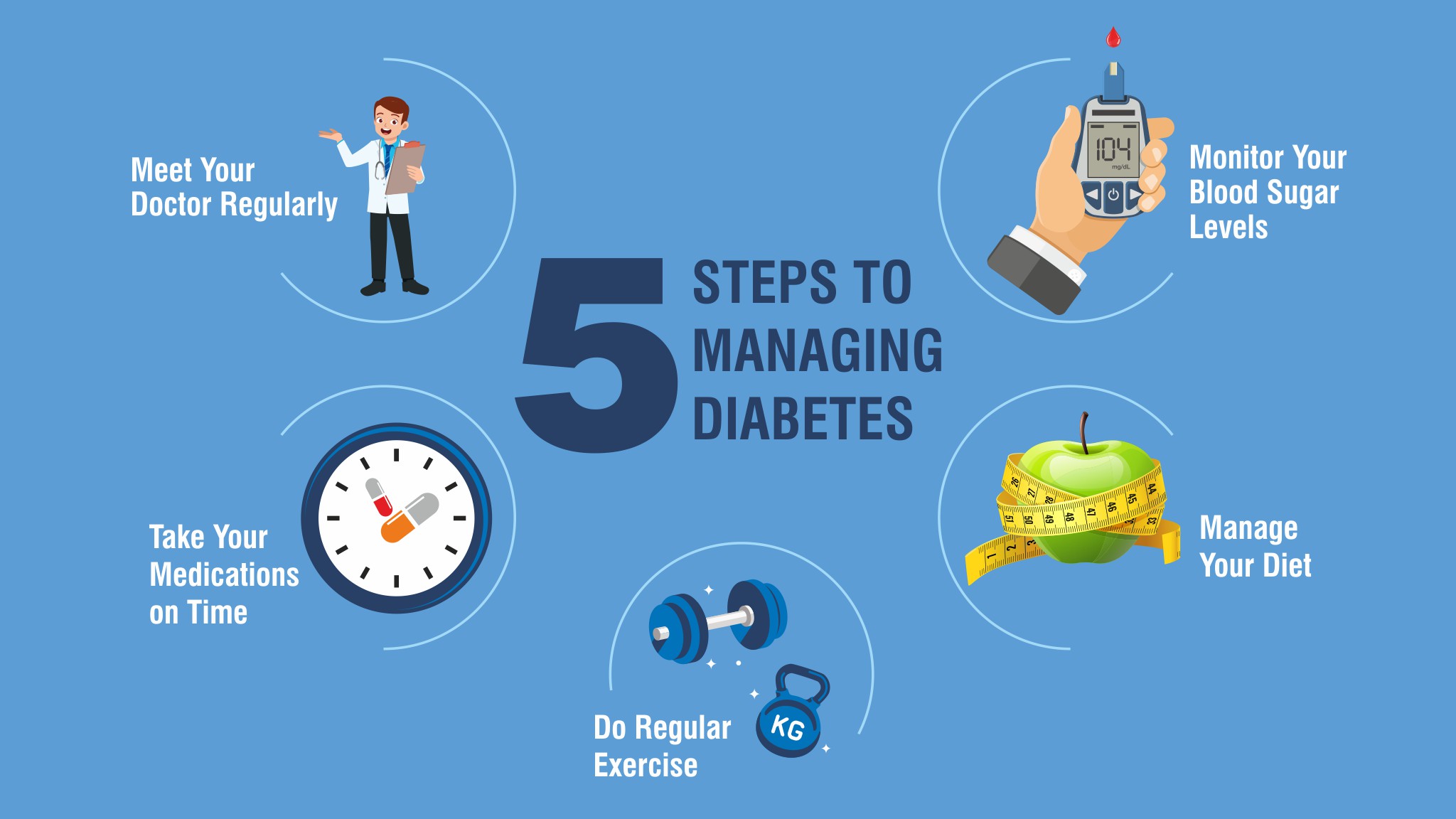Diabetes is a lifelong condition, but with the right lifestyle changes and consistent care, it is entirely manageable. According to Bayhealth Endocrinologist Dr. Nira Madisi, diabetes is not curable, but it doesn’t have to dominate your life. Through steady, achievable adjustments in diet, exercise, and self-care, individuals can gain control over their blood sugar levels and avoid the long-term complications associated with the disease.
Whether you have Type 1 or Type 2 diabetes, following these six essential steps can significantly improve your health and quality of life.

Step 1: Make Smart, Sustainable Dietary Choices
One of the most critical aspects of managing diabetes is being mindful of what you eat. Food has a direct impact on blood glucose levels, and adopting healthier eating habits can make a profound difference.
What to Eat:
-
Choose brown carbohydrates like brown rice, whole wheat bread, and whole-grain pasta. These complex carbs digest slower, helping stabilize blood sugar.
-
Incorporate high-fiber foods, which help slow glucose absorption and maintain balanced sugar levels.
-
Fill half of your plate with green, non-starchy vegetables such as broccoli, spinach, and zucchini.
-
Include lean protein like chicken, fish, or legumes in each meal.
What to Avoid:
-
Cut out white carbohydrates like white rice, white bread, and white potatoes.
-
Opt for alternatives like sweet potatoes or mashed cauliflower, both of which have a lower glycemic index and cause fewer blood sugar spikes.
-
Minimize sugar intake. Avoid sugary drinks, candy, pastries, and processed foods loaded with hidden sugars.
Plate Planning Tip:
Dr. Madisi recommends a simple visual guide: A fist-sized portion of carbs, half a plate of vegetables, and a quarter plate of lean protein.
Step 2: Stay Physically Active to Support Blood Sugar Balance
Exercise isn’t just beneficial for weight loss—it’s essential for blood sugar control. Regular movement helps your body use insulin more efficiently and improves circulation.
Recommended Activity Level:
-
Aim for 150 minutes of moderate-intensity exercise per week, such as brisk walking, swimming, or cycling.
-
A good benchmark: being able to walk a mile in about 20 minutes.
For Limited Mobility:
-
Try chair exercises or use household items like milk cartons filled with water for resistance training.
-
Even light activities like standing during TV commercials or taking short walks throughout the day can improve metabolic health.
Pro tip: Sitting too long can be as damaging as smoking. Make it a goal to move every 30–60 minutes.
Step 3: Practice Daily Foot Care
Foot care may seem unrelated to diabetes at first glance, but it’s crucial. Diabetes reduces circulation and damages nerves, making it easier for small injuries to become serious.
Daily Routine:
-
Inspect feet daily for blisters, cuts, or redness.
-
Wear properly fitting shoes and avoid going barefoot.
-
Moisturize your feet—but not between the toes—to prevent cracking.
If you spot any sores or abnormalities, see a healthcare provider immediately to prevent complications like infections or amputations.
Step 4: Focus on Healthy Weight Loss
Managing weight is especially important for individuals with Type 2 diabetes, where insulin resistance is a key issue. Weight loss can enhance insulin sensitivity and even reduce the need for medications in early stages.
Tips for Safe Weight Loss:
-
Walk at least 10,000 steps per day, which equals around five miles.
-
Track daily calorie intake using smartphone apps to stay accountable.
-
Explore quick and effective workouts, such as 12-minute home exercises, especially if you’re short on time.
Losing even a modest amount of weight—5–10% of your body weight—can dramatically improve blood sugar control.
Step 5: Take Medications as Prescribed
Medications are a vital part of diabetes management, especially for people with Type 1 diabetes, who do not produce insulin at all.
Medication Compliance:
-
Always take insulin and other medications as directed by your healthcare provider.
-
Missing doses can lead to serious complications including diabetic ketoacidosis or hospitalization.
-
Use reminders or apps to help keep track of your medication schedule.
Note: Even those with Type 2 diabetes, if not consistent, can face complications such as kidney failure, heart disease, or vision loss.
Step 6: Support Your Mental and Emotional Health
Living with a chronic illness can be overwhelming. That’s why it’s important to address not just your physical health but also your emotional well-being.
Mental Health Strategies:
-
Acknowledge feelings of stress, burnout, or depression.
-
Seek out support groups—in-person or online—for shared experiences and encouragement.
-
Consider professional counseling to manage anxiety or emotional struggles related to diabetes.
According to Dr. Madisi, understanding that “no one is perfect” and allowing yourself grace can help you stay motivated on the journey to better health.
Frequently Asked Questions:
What is the normal A1c range for someone with diabetes?
A well-controlled A1c level should be between 6.5% and 7% to minimize the risk of serious complications like heart disease or blindness.
Can I reverse Type 2 diabetes with lifestyle changes?
While Type 2 diabetes may not be “cured,” early and consistent lifestyle changes can greatly improve glucose control and even reduce the need for medications.
How can I reduce my sugar intake effectively?
Start by cutting out sugar-sweetened beverages and processed snacks. Opt for natural sweeteners in moderation and increase your fiber intake.
How often should I check my feet if I have diabetes?
Daily foot checks are recommended. Look for signs of redness, sores, or swelling and report any issues to your doctor immediately.
Are there quick workouts I can do at home for diabetes?
Yes! Apps offer short 12-minute workouts you can do at home. Also try chair exercises, brisk walking, or resistance bands for variety.




